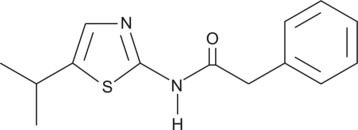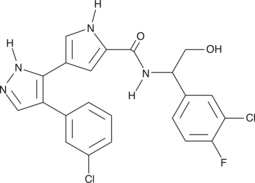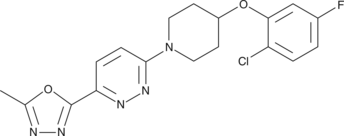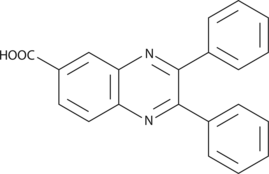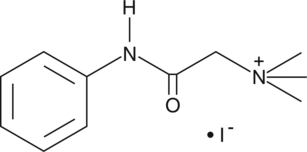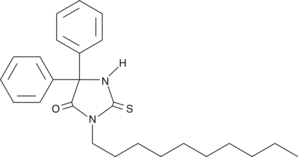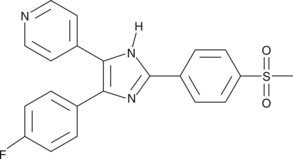Chemicals
Showing 13351–13500 of 41137 results
-
Anti-diabetic drugs of the thiazolidinedione (TZD) structural class as well as α-lipoic acid activate peroxisome proliferator-activated receptor γ (PPARγ), a nuclear transcription factor that controls glucose metabolism and lipid homeostasis. CAY10506 is a hybrid lipoic acid-TZD derivative that transactivates human PPARγ with an EC50 value of 10 µM.{14244}
Brand:CaymanSKU:10009079 - 50 mgAvailable on backorder
Central cannabinoid (CB1) receptor antagonists and inverse agonists exhibit therapeutic potential for obesity and drug dependence, while being devoid of psychotropic effects. CAY10508 is a potent and selective central cannabinoid (CB1) receptor inverse agonist with a Ki value of 243 nM and an EC50 of 195 nM.{14135} A 10 µM concentration of CAY10508 resulted in 100% and 35% displacement of [3H]-CP-55,940 at the CB1 and peripheral cannabinoid (CB2) receptors, respectively. A [35S]-GTPγS binding assay revealed the inverse agonist properties of CAY10508 at the CB1 receptor.
Brand:CaymanSKU:10008669 - 10 mgAvailable on backorder
Central cannabinoid (CB1) receptor antagonists and inverse agonists exhibit therapeutic potential for obesity and drug dependence, while being devoid of psychotropic effects. CAY10508 is a potent and selective central cannabinoid (CB1) receptor inverse agonist with a Ki value of 243 nM and an EC50 of 195 nM.{14135} A 10 µM concentration of CAY10508 resulted in 100% and 35% displacement of [3H]-CP-55,940 at the CB1 and peripheral cannabinoid (CB2) receptors, respectively. A [35S]-GTPγS binding assay revealed the inverse agonist properties of CAY10508 at the CB1 receptor.
Brand:CaymanSKU:10008669 - 25 mgAvailable on backorder
Central cannabinoid (CB1) receptor antagonists and inverse agonists exhibit therapeutic potential for obesity and drug dependence, while being devoid of psychotropic effects. CAY10508 is a potent and selective central cannabinoid (CB1) receptor inverse agonist with a Ki value of 243 nM and an EC50 of 195 nM.{14135} A 10 µM concentration of CAY10508 resulted in 100% and 35% displacement of [3H]-CP-55,940 at the CB1 and peripheral cannabinoid (CB2) receptors, respectively. A [35S]-GTPγS binding assay revealed the inverse agonist properties of CAY10508 at the CB1 receptor.
Brand:CaymanSKU:10008669 - 5 mgAvailable on backorder
Central cannabinoid (CB1) receptor antagonists and inverse agonists exhibit therapeutic potential for obesity and drug dependence, while being devoid of psychotropic effects. CAY10508 is a potent and selective central cannabinoid (CB1) receptor inverse agonist with a Ki value of 243 nM and an EC50 of 195 nM.{14135} A 10 µM concentration of CAY10508 resulted in 100% and 35% displacement of [3H]-CP-55,940 at the CB1 and peripheral cannabinoid (CB2) receptors, respectively. A [35S]-GTPγS binding assay revealed the inverse agonist properties of CAY10508 at the CB1 receptor.
Brand:CaymanSKU:10008669 - 50 mgAvailable on backorder
The actions of many clinical prostaglandins, including those used for estrous synchronization and for reduction of intraocular pressure, are mediated through the FP receptor.{2959} CAY10509 is an analog of PGF2α containing a thio-fluorobenzene substituent in the lower side chain. CAY10509 has an IC50 of about 30 nM when tested for binding to the recombinant human FP receptor.{14404}
Brand:CaymanSKU:10009167 - 1 mgAvailable on backorder
The actions of many clinical prostaglandins, including those used for estrous synchronization and for reduction of intraocular pressure, are mediated through the FP receptor.{2959} CAY10509 is an analog of PGF2α containing a thio-fluorobenzene substituent in the lower side chain. CAY10509 has an IC50 of about 30 nM when tested for binding to the recombinant human FP receptor.{14404}
Brand:CaymanSKU:10009167 - 100 µgAvailable on backorder
The actions of many clinical prostaglandins, including those used for estrous synchronization and for reduction of intraocular pressure, are mediated through the FP receptor.{2959} CAY10509 is an analog of PGF2α containing a thio-fluorobenzene substituent in the lower side chain. CAY10509 has an IC50 of about 30 nM when tested for binding to the recombinant human FP receptor.{14404}
Brand:CaymanSKU:10009167 - 5 mgAvailable on backorder
The actions of many clinical prostaglandins, including those used for estrous synchronization and for reduction of intraocular pressure, are mediated through the FP receptor.{2959} CAY10509 is an analog of PGF2α containing a thio-fluorobenzene substituent in the lower side chain. CAY10509 has an IC50 of about 30 nM when tested for binding to the recombinant human FP receptor.{14404}
Brand:CaymanSKU:10009167 - 500 µgAvailable on backorder
The actions of many clinical prostaglandins, including those used for estrous synchronization and for reduction of intraocular pressure, are mediated through the FP receptor.{2959} CAY10510 is an analog of PGF2α containing an acetylenic fluorobenzene substituent in the lower side chain. CAY10510 has an IC50 of 0.5 µM when tested for binding to the recombinant human FP receptor.{14404}
Brand:CaymanSKU:10009168 - 1 mgAvailable on backorder
The actions of many clinical prostaglandins, including those used for estrous synchronization and for reduction of intraocular pressure, are mediated through the FP receptor.{2959} CAY10510 is an analog of PGF2α containing an acetylenic fluorobenzene substituent in the lower side chain. CAY10510 has an IC50 of 0.5 µM when tested for binding to the recombinant human FP receptor.{14404}
Brand:CaymanSKU:10009168 - 100 µgAvailable on backorder
The actions of many clinical prostaglandins, including those used for estrous synchronization and for reduction of intraocular pressure, are mediated through the FP receptor.{2959} CAY10510 is an analog of PGF2α containing an acetylenic fluorobenzene substituent in the lower side chain. CAY10510 has an IC50 of 0.5 µM when tested for binding to the recombinant human FP receptor.{14404}
Brand:CaymanSKU:10009168 - 5 mgAvailable on backorder
The actions of many clinical prostaglandins, including those used for estrous synchronization and for reduction of intraocular pressure, are mediated through the FP receptor.{2959} CAY10510 is an analog of PGF2α containing an acetylenic fluorobenzene substituent in the lower side chain. CAY10510 has an IC50 of 0.5 µM when tested for binding to the recombinant human FP receptor.{14404}
Brand:CaymanSKU:10009168 - 500 µgAvailable on backorder
The nuclear factor-κB (NF-κB) regulates the expression of numerous genes involved in immunity and inflammation, cellular stress responses, growth, and apoptosis. Resveratrol, a polyphenolic trans-stilbene, is a known inhibitor of the activation of NF-κB and exhibits activity against a wide variety of cancer cells. CAY10512 is a substituted trans-stilbene analog of resveratrol that is 100-fold more potent as measured by antioxidant activity. The IC50 value for inhibition of TNFα-induced activation of NF-κB by CAY10512 is 0.15 µM compared to 20 µM by resveratrol.{14545}
Brand:CaymanSKU:10009536 - 10 mgAvailable on backorder
The nuclear factor-κB (NF-κB) regulates the expression of numerous genes involved in immunity and inflammation, cellular stress responses, growth, and apoptosis. Resveratrol, a polyphenolic trans-stilbene, is a known inhibitor of the activation of NF-κB and exhibits activity against a wide variety of cancer cells. CAY10512 is a substituted trans-stilbene analog of resveratrol that is 100-fold more potent as measured by antioxidant activity. The IC50 value for inhibition of TNFα-induced activation of NF-κB by CAY10512 is 0.15 µM compared to 20 µM by resveratrol.{14545}
Brand:CaymanSKU:10009536 - 100 mgAvailable on backorder
The nuclear factor-κB (NF-κB) regulates the expression of numerous genes involved in immunity and inflammation, cellular stress responses, growth, and apoptosis. Resveratrol, a polyphenolic trans-stilbene, is a known inhibitor of the activation of NF-κB and exhibits activity against a wide variety of cancer cells. CAY10512 is a substituted trans-stilbene analog of resveratrol that is 100-fold more potent as measured by antioxidant activity. The IC50 value for inhibition of TNFα-induced activation of NF-κB by CAY10512 is 0.15 µM compared to 20 µM by resveratrol.{14545}
Brand:CaymanSKU:10009536 - 50 mgAvailable on backorder
The nuclear factor-κB (NF-κB) regulates the expression of numerous genes involved in immunity and inflammation, cellular stress responses, growth, and apoptosis. Resveratrol, a polyphenolic trans-stilbene, is a known inhibitor of the activation of NF-κB and exhibits activity against a wide variety of cancer cells. CAY10512 is a substituted trans-stilbene analog of resveratrol that is 100-fold more potent as measured by antioxidant activity. The IC50 value for inhibition of TNFα-induced activation of NF-κB by CAY10512 is 0.15 µM compared to 20 µM by resveratrol.{14545}
Brand:CaymanSKU:10009536 - 500 mgAvailable on backorder
CAY10514 is an aromatic analog of 8(S)-HETE. It acts as a dual agonist of PPARα and PPARγ with EC50 values of 0.173 and 0.642 µM, respectively.{14310}
Brand:CaymanSKU:10009017 - 1 mgAvailable on backorder
CAY10514 is an aromatic analog of 8(S)-HETE. It acts as a dual agonist of PPARα and PPARγ with EC50 values of 0.173 and 0.642 µM, respectively.{14310}
Brand:CaymanSKU:10009017 - 10 mgAvailable on backorder
CAY10514 is an aromatic analog of 8(S)-HETE. It acts as a dual agonist of PPARα and PPARγ with EC50 values of 0.173 and 0.642 µM, respectively.{14310}
Brand:CaymanSKU:10009017 - 5 mgAvailable on backorder
CAY10514 is an aromatic analog of 8(S)-HETE. It acts as a dual agonist of PPARα and PPARγ with EC50 values of 0.173 and 0.642 µM, respectively.{14310}
Brand:CaymanSKU:10009017 - 50 mgAvailable on backorder
Prostaglandin E2 (PGE2) is the major PG synthesized at sites of inflammation and plays an important role in different inflammatory diseases. It acts as a mediator of pain and inflammation and promotes bone destruction. The increased synthesis of PGE2 during inflammation can be accounted for by increased expression of both cyclooxygenase-2 (COX-2) and microsomal PGE synthase-1 (mPGES-1).{11266,12923,11537} CAY10526 is an inhibitor of PGE2 production through the selective modulation of mPGES-1 expression. It dose-dependently inhibits PGE2 production in lipopolysaccharide-stimulated RAW 264.7 cells with an IC50 value of 1.8 µM without any effect on COX-2 expression.{14793}
Brand:CaymanSKU:10010088 - 1 mgAvailable on backorder
Prostaglandin E2 (PGE2) is the major PG synthesized at sites of inflammation and plays an important role in different inflammatory diseases. It acts as a mediator of pain and inflammation and promotes bone destruction. The increased synthesis of PGE2 during inflammation can be accounted for by increased expression of both cyclooxygenase-2 (COX-2) and microsomal PGE synthase-1 (mPGES-1).{11266,12923,11537} CAY10526 is an inhibitor of PGE2 production through the selective modulation of mPGES-1 expression. It dose-dependently inhibits PGE2 production in lipopolysaccharide-stimulated RAW 264.7 cells with an IC50 value of 1.8 µM without any effect on COX-2 expression.{14793}
Brand:CaymanSKU:10010088 - 10 mgAvailable on backorder
Prostaglandin E2 (PGE2) is the major PG synthesized at sites of inflammation and plays an important role in different inflammatory diseases. It acts as a mediator of pain and inflammation and promotes bone destruction. The increased synthesis of PGE2 during inflammation can be accounted for by increased expression of both cyclooxygenase-2 (COX-2) and microsomal PGE synthase-1 (mPGES-1).{11266,12923,11537} CAY10526 is an inhibitor of PGE2 production through the selective modulation of mPGES-1 expression. It dose-dependently inhibits PGE2 production in lipopolysaccharide-stimulated RAW 264.7 cells with an IC50 value of 1.8 µM without any effect on COX-2 expression.{14793}
Brand:CaymanSKU:10010088 - 5 mgAvailable on backorder
TPα and TPβ are two isoforms of the human TP receptor, the G protein-coupled receptor (GPCR) that mediates the actions of thromboxane A2 (TXA2). Although their distinct physiological functions have not been fully elucidated, TPβ is believed to be responsible for vascular endothelial growth factor-induced endothelial cell differentiation and migration whereas TPα appears to be the predominant isoform expressed in platelets. CAY10535 is a TP receptor antagonist that shows ~20-fold selectivity for TPβ (IC50 = 99 nM) relative to TPα (IC50 = 1,970 nM) in the inhibition of U46619-mediated Ca2+ mobilization. This compound exhibits relatively poor activity on platelets (IC50 = 985 nM) when inhibiting U-46619-induced platelet aggregation.{14983}
Brand:CaymanSKU:10010396 - 1 mgAvailable on backorder
TPα and TPβ are two isoforms of the human TP receptor, the G protein-coupled receptor (GPCR) that mediates the actions of thromboxane A2 (TXA2). Although their distinct physiological functions have not been fully elucidated, TPβ is believed to be responsible for vascular endothelial growth factor-induced endothelial cell differentiation and migration whereas TPα appears to be the predominant isoform expressed in platelets. CAY10535 is a TP receptor antagonist that shows ~20-fold selectivity for TPβ (IC50 = 99 nM) relative to TPα (IC50 = 1,970 nM) in the inhibition of U46619-mediated Ca2+ mobilization. This compound exhibits relatively poor activity on platelets (IC50 = 985 nM) when inhibiting U-46619-induced platelet aggregation.{14983}
Brand:CaymanSKU:10010396 - 10 mgAvailable on backorder
TPα and TPβ are two isoforms of the human TP receptor, the G protein-coupled receptor (GPCR) that mediates the actions of thromboxane A2 (TXA2). Although their distinct physiological functions have not been fully elucidated, TPβ is believed to be responsible for vascular endothelial growth factor-induced endothelial cell differentiation and migration whereas TPα appears to be the predominant isoform expressed in platelets. CAY10535 is a TP receptor antagonist that shows ~20-fold selectivity for TPβ (IC50 = 99 nM) relative to TPα (IC50 = 1,970 nM) in the inhibition of U46619-mediated Ca2+ mobilization. This compound exhibits relatively poor activity on platelets (IC50 = 985 nM) when inhibiting U-46619-induced platelet aggregation.{14983}
Brand:CaymanSKU:10010396 - 5 mgAvailable on backorder
TPα and TPβ are two isoforms of the human TP receptor, the G protein-coupled receptor (GPCR) that mediates the actions of thromboxane A2 (TXA2). Although their distinct physiological functions have not been fully elucidated, TPβ is believed to be responsible for vascular endothelial growth factor-induced endothelial cell differentiation and migration whereas TPα appears to be the predominant isoform expressed in platelets. CAY10535 is a TP receptor antagonist that shows ~20-fold selectivity for TPβ (IC50 = 99 nM) relative to TPα (IC50 = 1,970 nM) in the inhibition of U46619-mediated Ca2+ mobilization. This compound exhibits relatively poor activity on platelets (IC50 = 985 nM) when inhibiting U-46619-induced platelet aggregation.{14983}
Brand:CaymanSKU:10010396 - 50 mgAvailable on backorder
Cellular prion protein (PrPc) is a cell surface glycoprotein expressed in brain, spinal cord, and several peripheral tissues that if mutated to the protease-resistant isoform PrPSc (scrapie PrP, PrPres) can result in one of several fatal neurodegenerative diseases.{10289} Prion diseases, including mad cow disease (bovine spongiform encephalopathy), scrapie, and Creutzfeldt-Jakob disease develop from the accumulation of PrPSc, an abnormally folded β-rich conformation of PrPc.{11676,7171} CAY10550 is a potent antiprion compound that inhibits the accumulation of PrPc with an IC50 value of 3 nM in both ScN2a and F3 prion-infected mouse neuroblastoma cell lines.{15077} This compound also demonstrates moderate radical scavenging activity as it inhibits the formation of hydroxyl radicals in vitro with an IC50 value of 90 µM.{15077}
Brand:CaymanSKU:10010740 - 1 mgAvailable on backorder
Cellular prion protein (PrPc) is a cell surface glycoprotein expressed in brain, spinal cord, and several peripheral tissues that if mutated to the protease-resistant isoform PrPSc (scrapie PrP, PrPres) can result in one of several fatal neurodegenerative diseases.{10289} Prion diseases, including mad cow disease (bovine spongiform encephalopathy), scrapie, and Creutzfeldt-Jakob disease develop from the accumulation of PrPSc, an abnormally folded β-rich conformation of PrPc.{11676,7171} CAY10550 is a potent antiprion compound that inhibits the accumulation of PrPc with an IC50 value of 3 nM in both ScN2a and F3 prion-infected mouse neuroblastoma cell lines.{15077} This compound also demonstrates moderate radical scavenging activity as it inhibits the formation of hydroxyl radicals in vitro with an IC50 value of 90 µM.{15077}
Brand:CaymanSKU:10010740 - 10 mgAvailable on backorder
Cellular prion protein (PrPc) is a cell surface glycoprotein expressed in brain, spinal cord, and several peripheral tissues that if mutated to the protease-resistant isoform PrPSc (scrapie PrP, PrPres) can result in one of several fatal neurodegenerative diseases.{10289} Prion diseases, including mad cow disease (bovine spongiform encephalopathy), scrapie, and Creutzfeldt-Jakob disease develop from the accumulation of PrPSc, an abnormally folded β-rich conformation of PrPc.{11676,7171} CAY10550 is a potent antiprion compound that inhibits the accumulation of PrPc with an IC50 value of 3 nM in both ScN2a and F3 prion-infected mouse neuroblastoma cell lines.{15077} This compound also demonstrates moderate radical scavenging activity as it inhibits the formation of hydroxyl radicals in vitro with an IC50 value of 90 µM.{15077}
Brand:CaymanSKU:10010740 - 25 mgAvailable on backorder
Cellular prion protein (PrPc) is a cell surface glycoprotein expressed in brain, spinal cord, and several peripheral tissues that if mutated to the protease-resistant isoform PrPSc (scrapie PrP, PrPres) can result in one of several fatal neurodegenerative diseases.{10289} Prion diseases, including mad cow disease (bovine spongiform encephalopathy), scrapie, and Creutzfeldt-Jakob disease develop from the accumulation of PrPSc, an abnormally folded β-rich conformation of PrPc.{11676,7171} CAY10550 is a potent antiprion compound that inhibits the accumulation of PrPc with an IC50 value of 3 nM in both ScN2a and F3 prion-infected mouse neuroblastoma cell lines.{15077} This compound also demonstrates moderate radical scavenging activity as it inhibits the formation of hydroxyl radicals in vitro with an IC50 value of 90 µM.{15077}
Brand:CaymanSKU:10010740 - 5 mgAvailable on backorder
Cyclin-dependent kinases (CDKs) are key regulators of cell cycle progression and are therefore promising therapeutic targets for cancer and neurodegenerative diseases. Cyclin-dependent kinases (CDKs) are key regulators of cell cycle progression and are therefore promising therapeutic targets for cancer and neurodegenerative diseases. CAY10554 is a potent inhibitor of Cdk5 and Cdk2, with IC50 values of 64 and 98 nM, respectively.{15079}
Brand:CaymanSKU:10010301 - 10 mgAvailable on backorder
Cyclin-dependent kinases (CDKs) are key regulators of cell cycle progression and are therefore promising therapeutic targets for cancer and neurodegenerative diseases. Cyclin-dependent kinases (CDKs) are key regulators of cell cycle progression and are therefore promising therapeutic targets for cancer and neurodegenerative diseases. CAY10554 is a potent inhibitor of Cdk5 and Cdk2, with IC50 values of 64 and 98 nM, respectively.{15079}
Brand:CaymanSKU:10010301 - 25 mgAvailable on backorder
Cyclin-dependent kinases (CDKs) are key regulators of cell cycle progression and are therefore promising therapeutic targets for cancer and neurodegenerative diseases. Cyclin-dependent kinases (CDKs) are key regulators of cell cycle progression and are therefore promising therapeutic targets for cancer and neurodegenerative diseases. CAY10554 is a potent inhibitor of Cdk5 and Cdk2, with IC50 values of 64 and 98 nM, respectively.{15079}
Brand:CaymanSKU:10010301 - 5 mgAvailable on backorder
Cyclin-dependent kinases (CDKs) are key regulators of cell cycle progression and are therefore promising therapeutic targets for cancer and neurodegenerative diseases. Cyclin-dependent kinases (CDKs) are key regulators of cell cycle progression and are therefore promising therapeutic targets for cancer and neurodegenerative diseases. CAY10554 is a potent inhibitor of Cdk5 and Cdk2, with IC50 values of 64 and 98 nM, respectively.{15079}
Brand:CaymanSKU:10010301 - 50 mgAvailable on backorder
The extracellular signal-regulated kinase (ERK) signal transduction pathway regulates a diverse array of cellular processes. These processes include cell survival, proliferation, motility, and differentiation and are constitutively activated in cancers involving lung, colon, pancreas, kidney, and ovary.{15420} CAY10561 is a potent, ATP-competitive inhibitor of ERK2 (Ki = 2 nM).{14786} This compound is highly selective for ERK2 compared to other kinases such as PKA (Ki = 0.39 µM) and JNK3 (Ki = 4 µM).{14786} CAY10561 inhibits proliferation of COLO 205 cells with an IC50 value of 0.54 µM.{14786}
Brand:CaymanSKU:10010043 - 1 mgAvailable on backorder
The extracellular signal-regulated kinase (ERK) signal transduction pathway regulates a diverse array of cellular processes. These processes include cell survival, proliferation, motility, and differentiation and are constitutively activated in cancers involving lung, colon, pancreas, kidney, and ovary.{15420} CAY10561 is a potent, ATP-competitive inhibitor of ERK2 (Ki = 2 nM).{14786} This compound is highly selective for ERK2 compared to other kinases such as PKA (Ki = 0.39 µM) and JNK3 (Ki = 4 µM).{14786} CAY10561 inhibits proliferation of COLO 205 cells with an IC50 value of 0.54 µM.{14786}
Brand:CaymanSKU:10010043 - 10 mgAvailable on backorder
The extracellular signal-regulated kinase (ERK) signal transduction pathway regulates a diverse array of cellular processes. These processes include cell survival, proliferation, motility, and differentiation and are constitutively activated in cancers involving lung, colon, pancreas, kidney, and ovary.{15420} CAY10561 is a potent, ATP-competitive inhibitor of ERK2 (Ki = 2 nM).{14786} This compound is highly selective for ERK2 compared to other kinases such as PKA (Ki = 0.39 µM) and JNK3 (Ki = 4 µM).{14786} CAY10561 inhibits proliferation of COLO 205 cells with an IC50 value of 0.54 µM.{14786}
Brand:CaymanSKU:10010043 - 5 mgAvailable on backorder
The extracellular signal-regulated kinase (ERK) signal transduction pathway regulates a diverse array of cellular processes. These processes include cell survival, proliferation, motility, and differentiation and are constitutively activated in cancers involving lung, colon, pancreas, kidney, and ovary.{15420} CAY10561 is a potent, ATP-competitive inhibitor of ERK2 (Ki = 2 nM).{14786} This compound is highly selective for ERK2 compared to other kinases such as PKA (Ki = 0.39 µM) and JNK3 (Ki = 4 µM).{14786} CAY10561 inhibits proliferation of COLO 205 cells with an IC50 value of 0.54 µM.{14786}
Brand:CaymanSKU:10010043 - 500 µgAvailable on backorder
Stearoyl-CoA desaturase (SCD) catalyzes the committed step of the conversion of saturated, long-chain fatty acids to monounsaturated fatty acids. The SCD1 gene is thought to play a key role in lipid homeostasis and body weight regulation.{9969,16127,15602} Thus, modulating SCD1 activity pharmacologically may be a useful tool for regulating type 2 diabetes, dyslipidemia, and obesity. CAY10566 is a potent and selective inhibitor of SCD1 that demonstrates IC50 values of 4.5 and 26 nM in mouse and human enzymatic assays, respectively.{15724} This compound inhibits the conversion of saturated, long-chain fatty acyl-CoAs to monounsaturated, long-chain fatty acyl-CoAs in HepG2 cells with IC50 values of 7.9 and 6.8 nM, respectively, when heptadecanoic acid and palmitic acid are used as the substrate.{15724}
Brand:CaymanSKU:10012562 - 1 mgAvailable on backorder
Stearoyl-CoA desaturase (SCD) catalyzes the committed step of the conversion of saturated, long-chain fatty acids to monounsaturated fatty acids. The SCD1 gene is thought to play a key role in lipid homeostasis and body weight regulation.{9969,16127,15602} Thus, modulating SCD1 activity pharmacologically may be a useful tool for regulating type 2 diabetes, dyslipidemia, and obesity. CAY10566 is a potent and selective inhibitor of SCD1 that demonstrates IC50 values of 4.5 and 26 nM in mouse and human enzymatic assays, respectively.{15724} This compound inhibits the conversion of saturated, long-chain fatty acyl-CoAs to monounsaturated, long-chain fatty acyl-CoAs in HepG2 cells with IC50 values of 7.9 and 6.8 nM, respectively, when heptadecanoic acid and palmitic acid are used as the substrate.{15724}
Brand:CaymanSKU:10012562 - 10 mgAvailable on backorder
Stearoyl-CoA desaturase (SCD) catalyzes the committed step of the conversion of saturated, long-chain fatty acids to monounsaturated fatty acids. The SCD1 gene is thought to play a key role in lipid homeostasis and body weight regulation.{9969,16127,15602} Thus, modulating SCD1 activity pharmacologically may be a useful tool for regulating type 2 diabetes, dyslipidemia, and obesity. CAY10566 is a potent and selective inhibitor of SCD1 that demonstrates IC50 values of 4.5 and 26 nM in mouse and human enzymatic assays, respectively.{15724} This compound inhibits the conversion of saturated, long-chain fatty acyl-CoAs to monounsaturated, long-chain fatty acyl-CoAs in HepG2 cells with IC50 values of 7.9 and 6.8 nM, respectively, when heptadecanoic acid and palmitic acid are used as the substrate.{15724}
Brand:CaymanSKU:10012562 - 25 mgAvailable on backorder
Stearoyl-CoA desaturase (SCD) catalyzes the committed step of the conversion of saturated, long-chain fatty acids to monounsaturated fatty acids. The SCD1 gene is thought to play a key role in lipid homeostasis and body weight regulation.{9969,16127,15602} Thus, modulating SCD1 activity pharmacologically may be a useful tool for regulating type 2 diabetes, dyslipidemia, and obesity. CAY10566 is a potent and selective inhibitor of SCD1 that demonstrates IC50 values of 4.5 and 26 nM in mouse and human enzymatic assays, respectively.{15724} This compound inhibits the conversion of saturated, long-chain fatty acyl-CoAs to monounsaturated, long-chain fatty acyl-CoAs in HepG2 cells with IC50 values of 7.9 and 6.8 nM, respectively, when heptadecanoic acid and palmitic acid are used as the substrate.{15724}
Brand:CaymanSKU:10012562 - 5 mgAvailable on backorder
Akt1, 2, and 3 are serine/threonine protein kinases in the phosphatidylinositol 3 (PI3)-kinase signalling pathway that play a critical role in the regulation of cell proliferation and survival.{12235,13740} Following recruitment of Akt to the plasma membrane, phosphorylation at threonine 308 and serine 473 (Akt1 numbering) by phosphoinositide-dependent kinases (PDK) 1 and 2 results in full activation of the enzyme. CAY10567 is an Akt1 translocation inhibitor. At a concentration of 12.5 µM, it prevents the translocation of Akt1 by apparently compromising the function of the PH domain. A structurally similar compound inhibits kinase activity in vitro with an EC50 value of 12 µM by binding to the kinase domain.{15664} CAY10567 also inhibits hepatitis C virus (HCV) NS5B RNA-dependent RNA polymerase (RdRp) with an IC50 value of 79 µM. {15663}
Brand:CaymanSKU:-Akt1, 2, and 3 are serine/threonine protein kinases in the phosphatidylinositol 3 (PI3)-kinase signalling pathway that play a critical role in the regulation of cell proliferation and survival.{12235,13740} Following recruitment of Akt to the plasma membrane, phosphorylation at threonine 308 and serine 473 (Akt1 numbering) by phosphoinositide-dependent kinases (PDK) 1 and 2 results in full activation of the enzyme. CAY10567 is an Akt1 translocation inhibitor. At a concentration of 12.5 µM, it prevents the translocation of Akt1 by apparently compromising the function of the PH domain. A structurally similar compound inhibits kinase activity in vitro with an EC50 value of 12 µM by binding to the kinase domain.{15664} CAY10567 also inhibits hepatitis C virus (HCV) NS5B RNA-dependent RNA polymerase (RdRp) with an IC50 value of 79 µM. {15663}
Brand:CaymanSKU:10010233 - 1 gAvailable on backorder
Akt1, 2, and 3 are serine/threonine protein kinases in the phosphatidylinositol 3 (PI3)-kinase signalling pathway that play a critical role in the regulation of cell proliferation and survival.{12235,13740} Following recruitment of Akt to the plasma membrane, phosphorylation at threonine 308 and serine 473 (Akt1 numbering) by phosphoinositide-dependent kinases (PDK) 1 and 2 results in full activation of the enzyme. CAY10567 is an Akt1 translocation inhibitor. At a concentration of 12.5 µM, it prevents the translocation of Akt1 by apparently compromising the function of the PH domain. A structurally similar compound inhibits kinase activity in vitro with an EC50 value of 12 µM by binding to the kinase domain.{15664} CAY10567 also inhibits hepatitis C virus (HCV) NS5B RNA-dependent RNA polymerase (RdRp) with an IC50 value of 79 µM. {15663}
Brand:CaymanSKU:10010233 - 100 mgAvailable on backorder
Akt1, 2, and 3 are serine/threonine protein kinases in the phosphatidylinositol 3 (PI3)-kinase signalling pathway that play a critical role in the regulation of cell proliferation and survival.{12235,13740} Following recruitment of Akt to the plasma membrane, phosphorylation at threonine 308 and serine 473 (Akt1 numbering) by phosphoinositide-dependent kinases (PDK) 1 and 2 results in full activation of the enzyme. CAY10567 is an Akt1 translocation inhibitor. At a concentration of 12.5 µM, it prevents the translocation of Akt1 by apparently compromising the function of the PH domain. A structurally similar compound inhibits kinase activity in vitro with an EC50 value of 12 µM by binding to the kinase domain.{15664} CAY10567 also inhibits hepatitis C virus (HCV) NS5B RNA-dependent RNA polymerase (RdRp) with an IC50 value of 79 µM. {15663}
Brand:CaymanSKU:10010233 - 250 mgAvailable on backorder
Akt1, 2, and 3 are serine/threonine protein kinases in the phosphatidylinositol 3 (PI3)-kinase signalling pathway that play a critical role in the regulation of cell proliferation and survival.{12235,13740} Following recruitment of Akt to the plasma membrane, phosphorylation at threonine 308 and serine 473 (Akt1 numbering) by phosphoinositide-dependent kinases (PDK) 1 and 2 results in full activation of the enzyme. CAY10567 is an Akt1 translocation inhibitor. At a concentration of 12.5 µM, it prevents the translocation of Akt1 by apparently compromising the function of the PH domain. A structurally similar compound inhibits kinase activity in vitro with an EC50 value of 12 µM by binding to the kinase domain.{15664} CAY10567 also inhibits hepatitis C virus (HCV) NS5B RNA-dependent RNA polymerase (RdRp) with an IC50 value of 79 µM. {15663}
Brand:CaymanSKU:-Akt1, 2, and 3 are serine/threonine protein kinases in the phosphatidylinositol 3 (PI3)-kinase signalling pathway that play a critical role in the regulation of cell proliferation and survival.{12235,13740} Following recruitment of Akt to the plasma membrane, phosphorylation at threonine 308 and serine 473 (Akt1 numbering) by phosphoinositide-dependent kinases (PDK) 1 and 2 results in full activation of the enzyme. CAY10567 is an Akt1 translocation inhibitor. At a concentration of 12.5 µM, it prevents the translocation of Akt1 by apparently compromising the function of the PH domain. A structurally similar compound inhibits kinase activity in vitro with an EC50 value of 12 µM by binding to the kinase domain.{15664} CAY10567 also inhibits hepatitis C virus (HCV) NS5B RNA-dependent RNA polymerase (RdRp) with an IC50 value of 79 µM. {15663}
Brand:CaymanSKU:10010233 - 500 mgAvailable on backorder
Most local anesthetics act by abolishing voltage gated sodium channel currents indiscriminately in all populations of neurons. Selective analgesia through TRPV1-mediated entry of a cationic lidocaine derivative, QX314, was recently reported.{15625} CAY10568 is a physically smaller, less hydrophobic version of QX314 designed to be even more permeable to TRPV1 ion channel when activated by agonists such as capsaicin and N-oleoyl dopamine. CAY10568 when given in combination with suitable TRPV1 agonists should produce selective blockade of the pain response while leaving motor, touch, and proprioception intact.
Brand:CaymanSKU:10012565 - 10 mgAvailable on backorder
Most local anesthetics act by abolishing voltage gated sodium channel currents indiscriminately in all populations of neurons. Selective analgesia through TRPV1-mediated entry of a cationic lidocaine derivative, QX314, was recently reported.{15625} CAY10568 is a physically smaller, less hydrophobic version of QX314 designed to be even more permeable to TRPV1 ion channel when activated by agonists such as capsaicin and N-oleoyl dopamine. CAY10568 when given in combination with suitable TRPV1 agonists should produce selective blockade of the pain response while leaving motor, touch, and proprioception intact.
Brand:CaymanSKU:10012565 - 100 mgAvailable on backorder
Most local anesthetics act by abolishing voltage gated sodium channel currents indiscriminately in all populations of neurons. Selective analgesia through TRPV1-mediated entry of a cationic lidocaine derivative, QX314, was recently reported.{15625} CAY10568 is a physically smaller, less hydrophobic version of QX314 designed to be even more permeable to TRPV1 ion channel when activated by agonists such as capsaicin and N-oleoyl dopamine. CAY10568 when given in combination with suitable TRPV1 agonists should produce selective blockade of the pain response while leaving motor, touch, and proprioception intact.
Brand:CaymanSKU:10012565 - 25 mgAvailable on backorder
Most local anesthetics act by abolishing voltage gated sodium channel currents indiscriminately in all populations of neurons. Selective analgesia through TRPV1-mediated entry of a cationic lidocaine derivative, QX314, was recently reported.{15625} CAY10568 is a physically smaller, less hydrophobic version of QX314 designed to be even more permeable to TRPV1 ion channel when activated by agonists such as capsaicin and N-oleoyl dopamine. CAY10568 when given in combination with suitable TRPV1 agonists should produce selective blockade of the pain response while leaving motor, touch, and proprioception intact.
Brand:CaymanSKU:10012565 - 50 mgAvailable on backorder
The enzyme fatty acid amide hydrolase (FAAH) is capable of hydrolyzing and inactivating anandamide and other fatty acid amides that act as agonists for the central cannabinoid (CB1) receptor.{3310} CAY10570 is a reversible competitive inhibitor of FAAH activity exhibiting an IC50 value of 1.3 µM.{14794} CAY10570 has no affinity for the human CB1 receptor and acts as a competitive inhibitor of FAAH activity without being hydrolyzed by the enzyme.{14794}
Brand:CaymanSKU:10010032 - 1 mgAvailable on backorder
The enzyme fatty acid amide hydrolase (FAAH) is capable of hydrolyzing and inactivating anandamide and other fatty acid amides that act as agonists for the central cannabinoid (CB1) receptor.{3310} CAY10570 is a reversible competitive inhibitor of FAAH activity exhibiting an IC50 value of 1.3 µM.{14794} CAY10570 has no affinity for the human CB1 receptor and acts as a competitive inhibitor of FAAH activity without being hydrolyzed by the enzyme.{14794}
Brand:CaymanSKU:10010032 - 10 mgAvailable on backorder
The enzyme fatty acid amide hydrolase (FAAH) is capable of hydrolyzing and inactivating anandamide and other fatty acid amides that act as agonists for the central cannabinoid (CB1) receptor.{3310} CAY10570 is a reversible competitive inhibitor of FAAH activity exhibiting an IC50 value of 1.3 µM.{14794} CAY10570 has no affinity for the human CB1 receptor and acts as a competitive inhibitor of FAAH activity without being hydrolyzed by the enzyme.{14794}
Brand:CaymanSKU:10010032 - 5 mgAvailable on backorder
The enzyme fatty acid amide hydrolase (FAAH) is capable of hydrolyzing and inactivating anandamide and other fatty acid amides that act as agonists for the central cannabinoid (CB1) receptor.{3310} CAY10570 is a reversible competitive inhibitor of FAAH activity exhibiting an IC50 value of 1.3 µM.{14794} CAY10570 has no affinity for the human CB1 receptor and acts as a competitive inhibitor of FAAH activity without being hydrolyzed by the enzyme.{14794}
Brand:CaymanSKU:10010032 - 500 µgAvailable on backorder
Pyridinylimidazoles, often termed CSAIDs, are a class of anti-inflammatory compounds that inhibit eicosanoid production and suppress the synthesis of cytokines in human monocytes.{16246} Because of its high specificity, one predominant pyridinylimidazole, SB203580, is frequently used to inhibit p38 MAPK, the tyrosine kinase activated by environmental stresses and inflammatory cytokines.{15737} CAY10571 is an analog of SB203580. It inhibits IL-1 production in the human monocytic cell line THP with an IC50 value of 0.20 µM and binds CSAID binding protein, a serine/threonine kinase homologous to p38, inhibiting its kinase activity with an IC50 value of 0.03 µM.{16229,13876} CAY105571 also inhibits 5-lipoxygenase production in RBL-1 cells with an IC50 value of 24 µM.{16229}
Brand:CaymanSKU:10010400 - 10 mgAvailable on backorder
Pyridinylimidazoles, often termed CSAIDs, are a class of anti-inflammatory compounds that inhibit eicosanoid production and suppress the synthesis of cytokines in human monocytes.{16246} Because of its high specificity, one predominant pyridinylimidazole, SB203580, is frequently used to inhibit p38 MAPK, the tyrosine kinase activated by environmental stresses and inflammatory cytokines.{15737} CAY10571 is an analog of SB203580. It inhibits IL-1 production in the human monocytic cell line THP with an IC50 value of 0.20 µM and binds CSAID binding protein, a serine/threonine kinase homologous to p38, inhibiting its kinase activity with an IC50 value of 0.03 µM.{16229,13876} CAY105571 also inhibits 5-lipoxygenase production in RBL-1 cells with an IC50 value of 24 µM.{16229}
Brand:CaymanSKU:10010400 - 25 mgAvailable on backorder
Pyridinylimidazoles, often termed CSAIDs, are a class of anti-inflammatory compounds that inhibit eicosanoid production and suppress the synthesis of cytokines in human monocytes.{16246} Because of its high specificity, one predominant pyridinylimidazole, SB203580, is frequently used to inhibit p38 MAPK, the tyrosine kinase activated by environmental stresses and inflammatory cytokines.{15737} CAY10571 is an analog of SB203580. It inhibits IL-1 production in the human monocytic cell line THP with an IC50 value of 0.20 µM and binds CSAID binding protein, a serine/threonine kinase homologous to p38, inhibiting its kinase activity with an IC50 value of 0.03 µM.{16229,13876} CAY105571 also inhibits 5-lipoxygenase production in RBL-1 cells with an IC50 value of 24 µM.{16229}
Brand:CaymanSKU:10010400 - 5 mgAvailable on backorder
The peroxisome proliferator-activated receptors (PPARs) are lipid-activated transcription factors often used as drug targets for the treatment of metabolic disorders. CAY10573 is a PPAR agonist that displays potent binding at PPARα, γ, and δ with IC50 values of 113, 50, and 223 nM, respectively. It potently transactivates PPARα, γ, and δ with EC50 values of 8, 70, and 500 nM, respectively.{14166} CAY10573 demonstrates stronger binding and functional activity for PPARγ than the antidiabetic compound rosiglitazone (IC50 = 92 nM; EC50 = 220 nM).{14166}
Brand:CaymanSKU:10008846 - 1 mgAvailable on backorder
The peroxisome proliferator-activated receptors (PPARs) are lipid-activated transcription factors often used as drug targets for the treatment of metabolic disorders. CAY10573 is a PPAR agonist that displays potent binding at PPARα, γ, and δ with IC50 values of 113, 50, and 223 nM, respectively. It potently transactivates PPARα, γ, and δ with EC50 values of 8, 70, and 500 nM, respectively.{14166} CAY10573 demonstrates stronger binding and functional activity for PPARγ than the antidiabetic compound rosiglitazone (IC50 = 92 nM; EC50 = 220 nM).{14166}
Brand:CaymanSKU:10008846 - 10 mgAvailable on backorder
The peroxisome proliferator-activated receptors (PPARs) are lipid-activated transcription factors often used as drug targets for the treatment of metabolic disorders. CAY10573 is a PPAR agonist that displays potent binding at PPARα, γ, and δ with IC50 values of 113, 50, and 223 nM, respectively. It potently transactivates PPARα, γ, and δ with EC50 values of 8, 70, and 500 nM, respectively.{14166} CAY10573 demonstrates stronger binding and functional activity for PPARγ than the antidiabetic compound rosiglitazone (IC50 = 92 nM; EC50 = 220 nM).{14166}
Brand:CaymanSKU:10008846 - 5 mgAvailable on backorder
The peroxisome proliferator-activated receptors (PPARs) are lipid-activated transcription factors often used as drug targets for the treatment of metabolic disorders. CAY10573 is a PPAR agonist that displays potent binding at PPARα, γ, and δ with IC50 values of 113, 50, and 223 nM, respectively. It potently transactivates PPARα, γ, and δ with EC50 values of 8, 70, and 500 nM, respectively.{14166} CAY10573 demonstrates stronger binding and functional activity for PPARγ than the antidiabetic compound rosiglitazone (IC50 = 92 nM; EC50 = 220 nM).{14166}
Brand:CaymanSKU:10008846 - 500 µgAvailable on backorder
Cyclin-dependent kinases (CDKs) play a key role in regulating cell division by phosphorylating distinct substrates in different phases of the cell cycle. Cell cycle deregulation in many cancers often results from altered CDK activity. Thus, CDKs are potential pharmacological targets for anticancer agents. CAY10574 is a potent, selective inhibitor of Cdk9 in vitro with an IC50 value of 0.35 µM. It is also a competitive inhibitor of Cdk2-cyclin E with respect to ATP, with Ki and IC50 values of 13.3 and 20 µM, respectively.{16228} CAY10574 reduces the population of S-phase cells of the cancer cell line HT-29 and blocks proliferation of several other cancer cell lines including MCF-7, HOS, G361, and K562 cells with IC50 values of 33, 49, 64, and 62 µM, respectively.{16228}
Brand:CaymanSKU:10011247 - 1 mgAvailable on backorder
Cyclin-dependent kinases (CDKs) play a key role in regulating cell division by phosphorylating distinct substrates in different phases of the cell cycle. Cell cycle deregulation in many cancers often results from altered CDK activity. Thus, CDKs are potential pharmacological targets for anticancer agents. CAY10574 is a potent, selective inhibitor of Cdk9 in vitro with an IC50 value of 0.35 µM. It is also a competitive inhibitor of Cdk2-cyclin E with respect to ATP, with Ki and IC50 values of 13.3 and 20 µM, respectively.{16228} CAY10574 reduces the population of S-phase cells of the cancer cell line HT-29 and blocks proliferation of several other cancer cell lines including MCF-7, HOS, G361, and K562 cells with IC50 values of 33, 49, 64, and 62 µM, respectively.{16228}
Brand:CaymanSKU:10011247 - 10 mgAvailable on backorder
Cyclin-dependent kinases (CDKs) play a key role in regulating cell division by phosphorylating distinct substrates in different phases of the cell cycle. Cell cycle deregulation in many cancers often results from altered CDK activity. Thus, CDKs are potential pharmacological targets for anticancer agents. CAY10574 is a potent, selective inhibitor of Cdk9 in vitro with an IC50 value of 0.35 µM. It is also a competitive inhibitor of Cdk2-cyclin E with respect to ATP, with Ki and IC50 values of 13.3 and 20 µM, respectively.{16228} CAY10574 reduces the population of S-phase cells of the cancer cell line HT-29 and blocks proliferation of several other cancer cell lines including MCF-7, HOS, G361, and K562 cells with IC50 values of 33, 49, 64, and 62 µM, respectively.{16228}
Brand:CaymanSKU:10011247 - 5 mgAvailable on backorder
Cyclin-dependent kinases (CDKs) play a key role in regulating cell division by phosphorylating distinct substrates in different phases of the cell cycle. Cell cycle deregulation in many cancers often results from altered CDK activity. Thus, CDKs are potential pharmacological targets for anticancer agents. CAY10574 is a potent, selective inhibitor of Cdk9 in vitro with an IC50 value of 0.35 µM. It is also a competitive inhibitor of Cdk2-cyclin E with respect to ATP, with Ki and IC50 values of 13.3 and 20 µM, respectively.{16228} CAY10574 reduces the population of S-phase cells of the cancer cell line HT-29 and blocks proliferation of several other cancer cell lines including MCF-7, HOS, G361, and K562 cells with IC50 values of 33, 49, 64, and 62 µM, respectively.{16228}
Brand:CaymanSKU:10011247 - 50 mgAvailable on backorder
The NF-κB/Rel transcription factors, known to be involved in the regulation of pro-inflammatory cytokines and the pathogenesis of a variety of diseases, are present in the cytosol in an inactive state, complexed with inhibitory IκB proteins. NF-κB is activated upon degradation of IκB following IKK-α and IKK-β phosphorylation. IKK-ε, a homolog of IKK-α and IKK-β, can also activate NF-κB. IKK-ε is expressed predominantly in immune cells and is thought to play a role in the immune response. CAY10575 is a benzimidazole analog that inhibits IKK-ε with an IC50 value of ~15.8 µM.{16237}
Brand:CaymanSKU:10011248 - 1 mgAvailable on backorder
The NF-κB/Rel transcription factors, known to be involved in the regulation of pro-inflammatory cytokines and the pathogenesis of a variety of diseases, are present in the cytosol in an inactive state, complexed with inhibitory IκB proteins. NF-κB is activated upon degradation of IκB following IKK-α and IKK-β phosphorylation. IKK-ε, a homolog of IKK-α and IKK-β, can also activate NF-κB. IKK-ε is expressed predominantly in immune cells and is thought to play a role in the immune response. CAY10575 is a benzimidazole analog that inhibits IKK-ε with an IC50 value of ~15.8 µM.{16237}
Brand:CaymanSKU:10011248 - 10 mgAvailable on backorder
The NF-κB/Rel transcription factors, known to be involved in the regulation of pro-inflammatory cytokines and the pathogenesis of a variety of diseases, are present in the cytosol in an inactive state, complexed with inhibitory IκB proteins. NF-κB is activated upon degradation of IκB following IKK-α and IKK-β phosphorylation. IKK-ε, a homolog of IKK-α and IKK-β, can also activate NF-κB. IKK-ε is expressed predominantly in immune cells and is thought to play a role in the immune response. CAY10575 is a benzimidazole analog that inhibits IKK-ε with an IC50 value of ~15.8 µM.{16237}
Brand:CaymanSKU:10011248 - 25 mgAvailable on backorder
The NF-κB/Rel transcription factors, known to be involved in the regulation of pro-inflammatory cytokines and the pathogenesis of a variety of diseases, are present in the cytosol in an inactive state, complexed with inhibitory IκB proteins. NF-κB is activated upon degradation of IκB following IKK-α and IKK-β phosphorylation. IKK-ε, a homolog of IKK-α and IKK-β, can also activate NF-κB. IKK-ε is expressed predominantly in immune cells and is thought to play a role in the immune response. CAY10575 is a benzimidazole analog that inhibits IKK-ε with an IC50 value of ~15.8 µM.{16237}
Brand:CaymanSKU:10011248 - 5 mgAvailable on backorder
The NF-κB/Rel transcription factors, known to be involved in the regulation of pro-inflammatory cytokines and the pathogenesis of a variety of diseases, are present in the cytosol in an inactive state, complexed with inhibitory IκB proteins. NF-κB is activated upon degradation of IκB following IKKα and IKKβ phosphorylation. IKKε, a homolog of IKKα and IKKβ, can also activate NF-κB. IKKε is expressed predominantly in immune cells, and is thought to play a role in the immune response. CAY10576 is a benzimidazole analog that selectively inhibits IKKε with an IC50 value of 40 nM and is essentially inactive at IKKα and IKKβ.{16237}
Brand:CaymanSKU:10011249 - 1 mgAvailable on backorder
The NF-κB/Rel transcription factors, known to be involved in the regulation of pro-inflammatory cytokines and the pathogenesis of a variety of diseases, are present in the cytosol in an inactive state, complexed with inhibitory IκB proteins. NF-κB is activated upon degradation of IκB following IKKα and IKKβ phosphorylation. IKKε, a homolog of IKKα and IKKβ, can also activate NF-κB. IKKε is expressed predominantly in immune cells, and is thought to play a role in the immune response. CAY10576 is a benzimidazole analog that selectively inhibits IKKε with an IC50 value of 40 nM and is essentially inactive at IKKα and IKKβ.{16237}
Brand:CaymanSKU:10011249 - 10 mgAvailable on backorder
The NF-κB/Rel transcription factors, known to be involved in the regulation of pro-inflammatory cytokines and the pathogenesis of a variety of diseases, are present in the cytosol in an inactive state, complexed with inhibitory IκB proteins. NF-κB is activated upon degradation of IκB following IKKα and IKKβ phosphorylation. IKKε, a homolog of IKKα and IKKβ, can also activate NF-κB. IKKε is expressed predominantly in immune cells, and is thought to play a role in the immune response. CAY10576 is a benzimidazole analog that selectively inhibits IKKε with an IC50 value of 40 nM and is essentially inactive at IKKα and IKKβ.{16237}
Brand:CaymanSKU:10011249 - 5 mgAvailable on backorder
The NF-κB/Rel transcription factors, known to be involved in the regulation of pro-inflammatory cytokines and the pathogenesis of a variety of diseases, are present in the cytosol in an inactive state, complexed with inhibitory IκB proteins. NF-κB is activated upon degradation of IκB following IKKα and IKKβ phosphorylation. IKKε, a homolog of IKKα and IKKβ, can also activate NF-κB. IKKε is expressed predominantly in immune cells, and is thought to play a role in the immune response. CAY10576 is a benzimidazole analog that selectively inhibits IKKε with an IC50 value of 40 nM and is essentially inactive at IKKα and IKKβ.{16237}
Brand:CaymanSKU:10011249 - 50 mgAvailable on backorder
Casein kinase 2 (CK2) is a serine/threonine-selective protein kinase involved in many signal transduction pathways. CK2 is known to negatively regulate apoptosis and its activity is increased in many proliferating tissues and tumors, which lends promise as an anti-cancer drug target. CAY10577 inhibits CK2 with an IC50 value of 0.8 µM.{16238}
Brand:CaymanSKU:10011256 - 1 mgAvailable on backorder
Casein kinase 2 (CK2) is a serine/threonine-selective protein kinase involved in many signal transduction pathways. CK2 is known to negatively regulate apoptosis and its activity is increased in many proliferating tissues and tumors, which lends promise as an anti-cancer drug target. CAY10577 inhibits CK2 with an IC50 value of 0.8 µM.{16238}
Brand:CaymanSKU:10011256 - 10 mgAvailable on backorder
Casein kinase 2 (CK2) is a serine/threonine-selective protein kinase involved in many signal transduction pathways. CK2 is known to negatively regulate apoptosis and its activity is increased in many proliferating tissues and tumors, which lends promise as an anti-cancer drug target. CAY10577 inhibits CK2 with an IC50 value of 0.8 µM.{16238}
Brand:CaymanSKU:10011256 - 5 mgAvailable on backorder
Casein kinase 2 (CK2) is a serine/threonine-selective protein kinase involved in many signal transduction pathways. CK2 is known to negatively regulate apoptosis and its activity is increased in many proliferating tissues and tumors, which lends promise as an anti-cancer drug target. CAY10577 inhibits CK2 with an IC50 value of 0.8 µM.{16238}
Brand:CaymanSKU:10011256 - 50 mgAvailable on backorder

![A potent and selective CB1 receptor inverse agonist (Ki = 243 nM; EC50 = 195 nM); a 10 µM concentration results in 100% and 35% displacement of [3H]-CP-55](https://interpriseusa.com/wp-content/uploads/2021/06/10008669.png)







